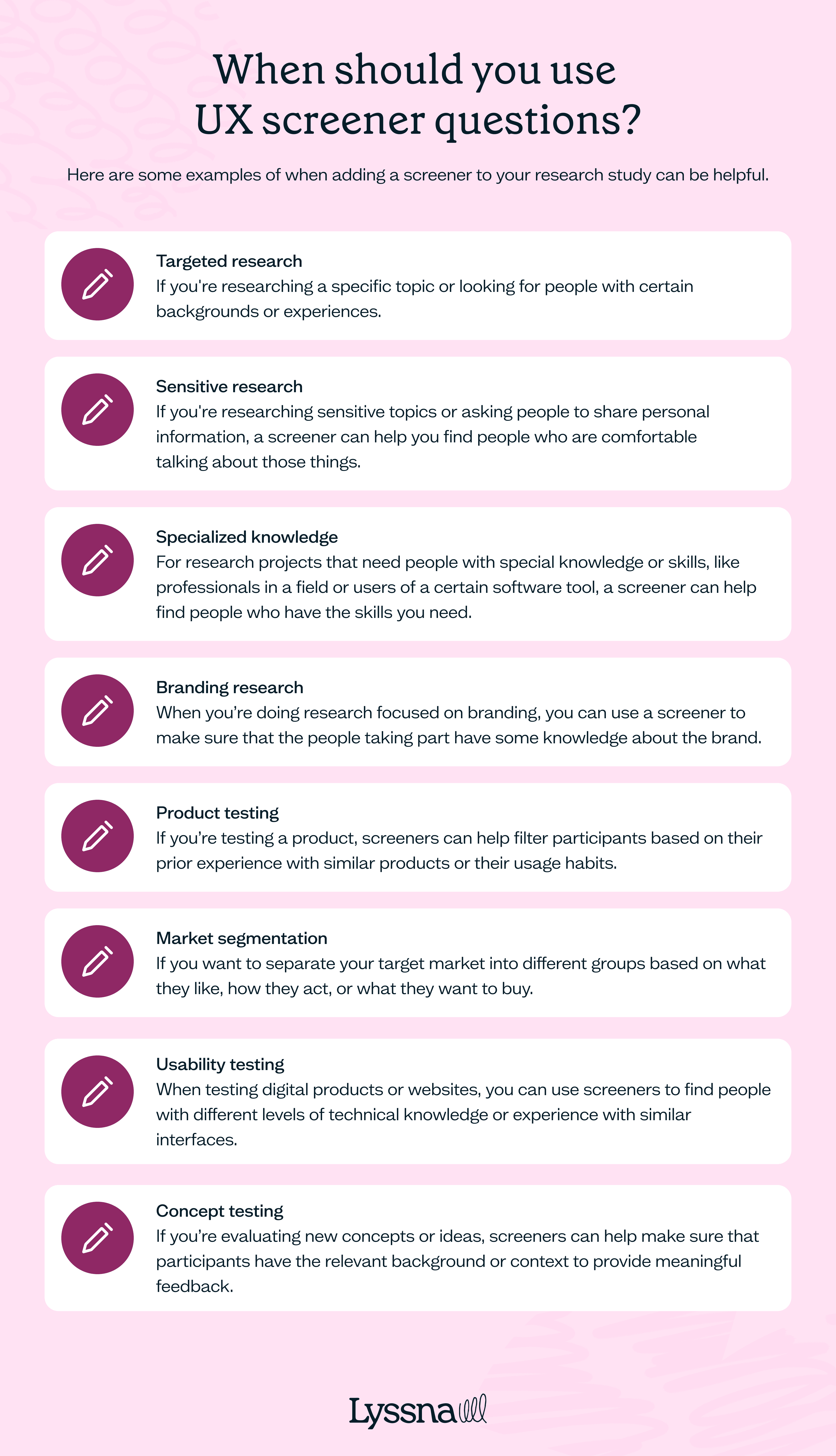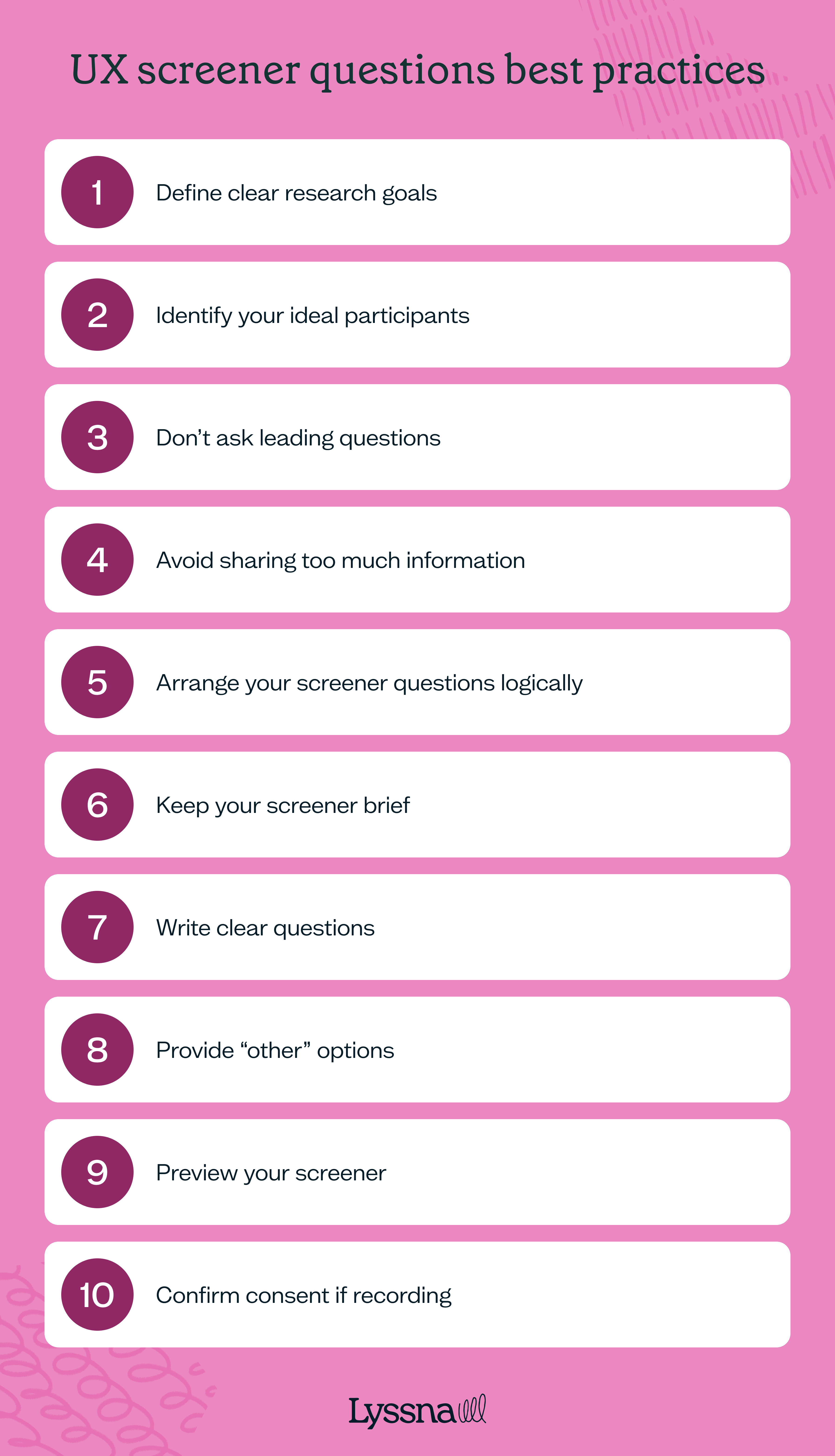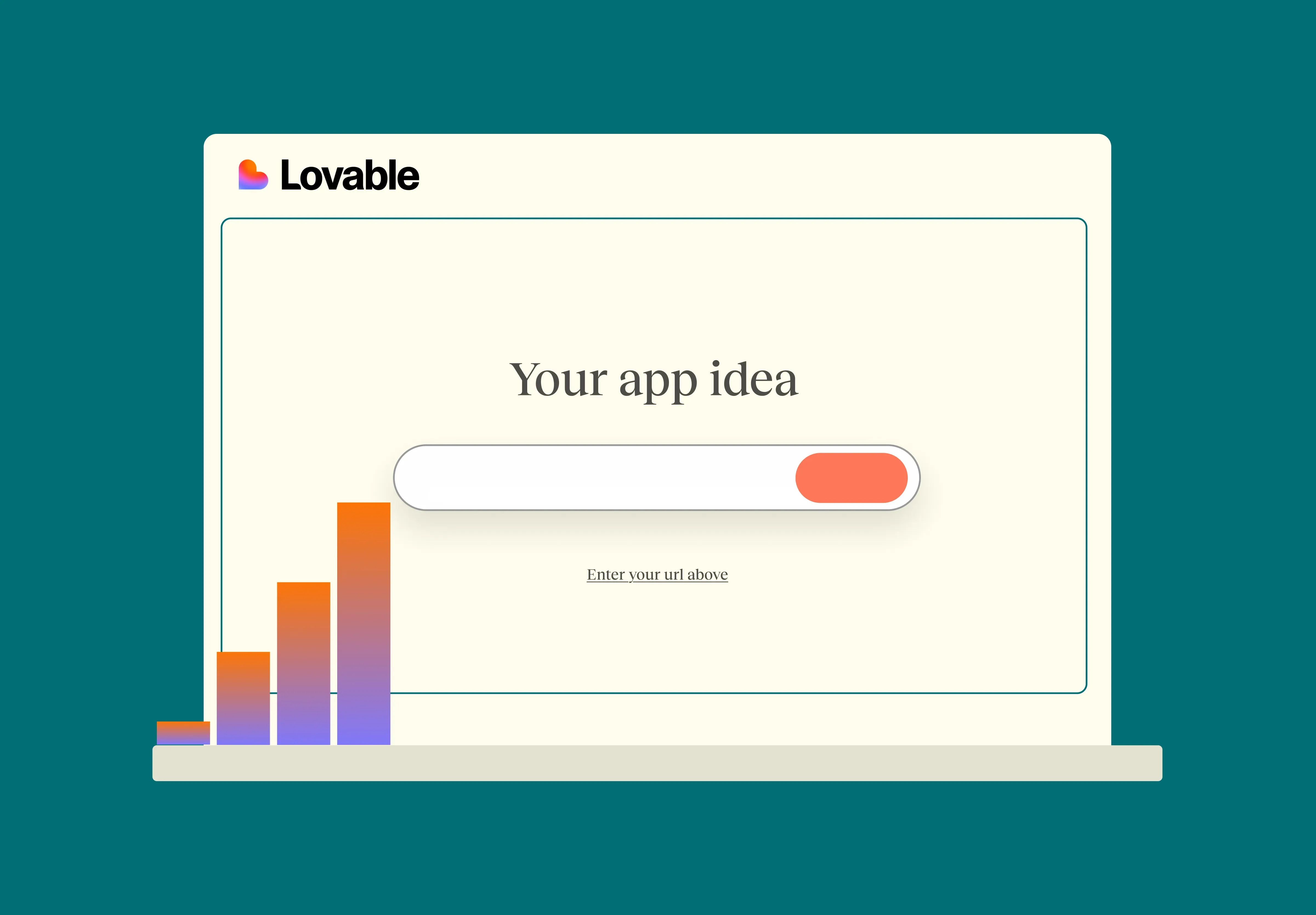09 Oct 2025
|19 min
UX screener questions
Discover how to craft effective UX screener questions and target the right research participants with our best practices and example questions.

We all know that conducting research is important when designing user-friendly products and services. But finding the right people to take part in research can be hard. This is where UX screener questions come in to make things that bit easier.
Screener questions are a useful tool to find the best people for your research. They help you gather important information, from demographics to experiences, technical know-how, and more.
In this article, we’ll explore UX screener questions. We’ll cover why and when to use them, best practices, and share examples of effective questions that you can copy and adapt the next time you run a study.

Why use UX screener questions?
One of the most important things to do when conducting research is to make sure you're getting feedback from the right people.
By asking a series of targeted questions, you can filter out participants who don't meet your criteria and make sure that you're only collecting data from those who are relevant to your study, which can lead to more targeted and quality insights.
Daniel Moon, Senior UX Researcher at The Chamberlain Group, stresses the importance of using a screener to identify the target audience accurately. He explains, “By not having a screener, it can cause a significant problem because your data won’t be reliable, as it doesn’t reflect the true population of who you’re trying to study.”
Survey screeners can also make your research easier. They help you find the right people to interview or test with faster. This is especially helpful if you have a short deadline or a small budget.
Shuying Lin, co-founder of Subrosa.ai, highlights the value she sees in screener questions: “They give us a chance to filter and know potential interviewees before stepping into user interviews. It also helps us run a short demographic survey as part of the whole discovery process.” Once you’ve used screener questions to filter your participants, the next step is conducting the actual interviews. That’s where having the right user interview questions becomes crucial.
When should you use UX screener questions?

Adding a screener is a good idea when you want to make sure that the people in your study meet certain requirements that are important for your research. This is true for all research studies, including surveys, unmoderated usability tests, and user interviews.
Here are some examples of when adding a screener can be helpful.
Targeted research: If you're researching a specific topic or looking for people with certain backgrounds or experiences.
Sensitive research: If you're researching sensitive topics or asking people to share personal information, a screener can help you find people who are comfortable talking about those things.
Specialized knowledge: For research projects that need people with special knowledge or skills, like professionals in a field or users of a certain software tool, a screener can help find people who have the skills you need.
Branding research: When you’re doing research focused on branding, you can use a screener to make sure that the people taking part have some knowledge about the brand.
Product testing: If you’re testing a product, screeners can help filter participants based on their prior experience with similar products or their usage habits.
Market segmentation: If you want to separate your target market into different groups based on things like what they like, how they act, or what they want to buy, screeners can help you find people who fit into each group.
Usability testing: When testing digital products or websites, you can use screeners to find people with different levels of technical knowledge or experience with similar interfaces. This way, you can change your testing scenarios to fit different groups of users.
Concept testing: If you’re evaluating new concepts or ideas, screeners can help make sure that participants have the relevant background or context to provide meaningful feedback. See our in-depth guide on concept testing questionnaire.
Try Screeners in Lyssna
Add a screener to your next study and recruit from our panel. With Lyssna, you can target specific criteria and find the right people for your research, with 395 demographic and psychographic options to choose from.
Best practices for using UX screener questions

Okay, so we’ve learned what screener questions are and when they’re helpful. Now, let’s talk about the best ways to use them. By following these tips, you can make sure your screener questions are on point and get the results you want.
Define clear research goals
Before you write your screener questions, think about what you're trying to find out. Knowing what your goals are will help you decide what questions to ask and what answers to include.
For example, if you’re testing user preferences for a new food delivery app, you can ask questions to find people who use food delivery apps and have experience with various platforms:
Do you currently use any food delivery apps?
Yes / No
How often do you order food for delivery?
Almost every day
2–3 times a week
Once a week
2–3 times a month
Once a month or less
Which food delivery apps do you use regularly? Select all that apply.
Uber Eats
DoorDash
Grubhub
Postmates
Instacart
Caviiar
ChowNow
Slice
Delivery.com
EatStreat
None of the above
Identify your ideal participants
This one might sound obvious, but it’s important to know who you want to study before you start your research. Think about things like: How old are they? Where do they live? What do they like to do? How do they act?
Once you know who you’re looking for, you can create questions that will help you collect the most useful information. For example, if you're testing a fitness app, you might want to talk to people who work out daily and have a smartphone.
Don’t ask leading questions
Questions that suggest a certain answer can make people more likely to give that answer. Instead, write neutral screener questions to avoid bias. Don’t use phrases like “Isn’t it true that” and “Don’t you think that”. These phrases may suggest a preferred answer.
For example, you could change a leading question like “Wouldn’t you say that our app is user-friendly” to “How would you rate the user-friendliness of our app on a scale of 1 to 5?”.
Daniel adds to this, “It’s important to avoid experimenter effects, where your screener questions could influence your participants’ answers because they’re trying to qualify for your study. People who take surveys are typically awarded with an incentive, and so they can lie to qualify.
“Instead of saying, ‘Do you own a Honda?’ say ‘Which of the following cars do you own?’, and then provide a laundry list of cars.”
Avoid sharing too much information
Give participants enough information to understand your study, but don't share details that could change their answers. Make your screener questions general. This will help keep participants impartial and avoid biased responses.
For example, instead of saying, “We're researching user preferences for our new fitness app,” you could say, “We're doing a study on health and wellness apps.” This gives participants a general idea of what the study is about without giving away specific details that might affect their answers.
Arrange your screener questions logically
When creating a screener, start with general questions about people's basic information, such as age and gender. Then, move on to more specific questions about their behaviors or preferences. This way, people who don't qualify for the survey won't waste time answering questions that don't apply to them.
Keep your screener brief
Keep your screener short and to the point. A short screener is more likely to be completed, especially when you’re looking for people with specific traits. Don’t lose participants by making your screener too long.
Nassir adds that, “Depending on the complexity of the project, I would ask the most critical questions early and then close – usually no more than 5 questions.”
Write clear questions
When writing screener questions, use clear and simple language. Don’t use jargon, acronyms, or ambiguous terms that your participants might not know.
Be specific when describing how often something happens. Don't use general words like "often," "rarely," or "sometimes." These words can mean different things to different people. This can lead to people giving different answers to your questions. Instead, use specific numbers or ranges. For example, you could say "once a day" or "between 1 and 3 times a week." This will help make sure that everyone understands what you mean.
Make sure your answer choices are clear and don't overlap. This is especially important when asking about numbers, like age, size, or frequency. For example, instead of using ranges like 18–25, 25–35, 35–45, etc., use ranges that don't overlap, such as 18–24, 25–34, 35–44, 45–54, 55–64, 65–74, 75+.
Provide “other” options
To make sure the information you gather is correct, give people different options to choose from, like "Other," "I don't know," or "None of the above." This way, people don't have to pick an answer that isn't right just to move on to the next question.
Preview your screener
Before you send your test to participants, review your screener questions. Make sure they're clear and easy to understand. Answer the questions yourself and ask your team for their thoughts. If there are any questions that seem unnecessary or confusing, remove them.
Daniel recommends passing your screener through “multiple reviewers before it’s launched, because different stakeholders may have varying viewpoints of who the target audience is.”
Confirm consent if recording
If you’re conducting a test that involves some level of recording, then it's important to check if participants are comfortable being recorded. Nassir suggests adding this as a question at the end of a screener.
“I can’t begin to describe the disappointment you’ll face if you find a good fit and, on the day when gaining verbal consent to recording, they say no.“

Pitfalls to avoid with screener questions
UX professionals from the Lyssna community shared some of the common mistakes to look out for when writing or adding screener questions to tests. With their first-hand experience, you can sidestep any potential pitfalls.
Relying on demographics
If you rely heavily on demographics, then you’ll only get a partial understanding of the user experience. Nassir shares this example: “King Charles and Ozzy Osbourne share common demographic data. Same age, both male, both raised in the UK, both married twice and both live in a castle. Yet, they are vastly different people and hold different beliefs, attitudes and behaviors.”
Be sure to check out the UX screener examples below and use different types of questions.
Not including behavioral questions
It’s often more important to understand users’ behavior rather than their attitudes. Nassir advises that, “It’s wise to include behavioral questions to really nail down the exact kind of people you wish to speak and test with.
“A very simple example – let’s say I want to test with gamers who play on a daily basis. I’ll be best poised to ask a ‘how often do you’ question to gauge whether a potential participant pays video games once or twice a week (someone we don’t want) or they play video games on a daily basis, in which case would be the people we would want to recruit.”
Be aware of professional testers
According to UX researcher Nassir Mohamud, it’s worth being aware that there may be a very small number of people who don’t have the most honorable intentions. “They engage in fraudulent activity to qualify themselves into your study solely to get the money or incentives. So I like to set up traps to filter participants.”
To help combat this, Nassir “includes a multiple-choice question, but one of the choices is wrong. Be sure to keep it specific to the subject of your project, but the idea here is to be creative and clever. Usually one of these questions does the trick for me.”
In addition, Daniel advises researchers to make it difficult for participants to guess the purpose behind screener questions. He finds that participants may try to guess what will make them eligible for the incentive.
UX screener question examples
Now that we’ve covered all those best practices, let’s get to the fun part – writing your screener questions!
Here, you'll find example screener questions that you can use as inspiration, or copy and change to fit your own studies.
Get started with Screeners using our pre-built templates – easily customize them to suit your needs:
Demographic
Demographic questions are great when you want to know more about your participants. They can tell you things like their age, gender, education level, and job. You should ask these questions if you need to group your participants based on their demographics – this will help you make sure that your study includes a variety of people.
Example questions:
Question: What's your annual household income?
Answers:
Below $25,000
$25,001 - $50,000
$50,001 - $75,000
$75,001 - $100,000
Above $100,000
Format: Single-choice
Question: How would you describe your marital status?
Answers:
Single
Married
De facto
Divorced
Widowed
Prefer not to say
Format: Single-choice
Psychographic
Psychographic questions help us understand people's attitudes, interests, and lifestyles. This information can be very helpful when designing experiences for different groups of people.
Example questions:
Question: Which of the following best describes your typical weekend activity?
Answers:
Outdoor activities (hiking, biking, etc.)
Socializing with friends or attending events
Relaxing at home with a book or movie
Other
Format: Multiple-choice
Question: How do you typically unwind after a stressful day?
Answers:
Engage in physical exercise or sports
Practice mindfulness or meditation
Spend time with loved ones or pets
Indulge in hobbies or creative activities
Other
Format: Multiple-choice
When creating a screener, it's important to keep it short and to the point. To avoid asking too many questions, prioritize psychographics over demographics. Demographics can give you some basic information, but behaviors and psychographics can give you a much deeper understanding of people’s experiences. This will lead to more meaningful research outcomes.
Product knowledge
Product knowledge questions are ideal when you want to know how familiar people are with a certain brand or product. They’re especially helpful if you’re researching a brand and want to make sure people know enough to give useful feedback.
Example questions:
Question: On a scale from 1 to 5, how familiar are you with [product/service]?
Answers:
1: Not at all familiar
5: Extremely familiar
Format: Linear scale (1–5)
Question: Which of the following features have you used in [product/service]?
Answers:
Feature A
Feature B
Feature C
Feature D
None of the above
Format: Multiple-choice
Frequency of use or action
Frequency of use or frequency of action questions help you learn how often people do something or use something. Use these questions when you want to find people who use a product or service often, or when you want to understand how people use something over time.
Example questions:
Question: How often did you use [product/service] in the past month?
Answers:
Daily
2–3 times a week
Once a week
Twice a month
Once a month
Never
Format: Single-choice
Question: When was the last time you used [product/service]?
Answers:
Today
Within the past week
Within the past month
Within the past 6 months
More than 6 months ago
Never
Format: Single-choice

Frequency of performing specific tasks
Questions related to the frequency of performing specific tasks are great when you want to know how often people do certain things. This is useful if you're studying people's habits or choices related to things they do regularly.
Example questions:
Question: How often do you exercise?
Answers:
Every day
2–3 times a week
Once a week
2–3 times a month
Rarely
Never
Format: Single-choice
Question: How often do you shop online?
Answers:
Multiple times a week
Once a week
Once a month
Once every three months
Once every six months
Once a year
Never
Format: Single-choice
Technical know-how
Questions about technical knowledge are useful when you want to know how comfortable your participants are with technology or technical concepts.
Example questions:
Question: How comfortable are you using a smartphone?
Answers:
Very comfortable
Comfortable
Neutral
Uncomfortable
Very uncomfortable
Format: Single-choice or Linear scale (1–5)
Question: How familiar are you with using a smartwatch for tracking activities and notifications?
Answers:
Very familiar
Somewhat familiar
Neutral
Somewhat unfamiliar
Very unfamiliar
Format: Single-choice or Linear scale (1–5)
Experience level with specific software or tools
These questions are useful when you want to find out how people use software applications and tools. This is helpful when you’re researching specific software products or tools and want to find people who know about them or have used them before.
Example questions:
Question: How comfortable are you using Figma?
Answers:
Not at all comfortable
Slightly comfortable
Moderately comfortable
Very comfortable
Extremely comfortable
Format: Single-choice or Linear scale (1–5)
Question: How proficient are you with using Google Analytics?
Answers:
Not familiar at all
Somewhat familiar
Very familiar
Format: Single-choice
Industry or occupation
When you ask participants about their industry or job, you can group them based on their professional backgrounds. This is helpful if your research focuses on specific industries or job roles, or if you need people with expertise in certain areas.
Example questions:
Question: Which industry do you work in?
Answers:
Retail
Information technology (IT)
Healthcare
Education
Finance
Marketing
Engineering
Hospitality
Media and communications
Manufacturing
Other
Format: Single-choice
Question: Which category best describes your job function?
Answers:
Marketing
Sales
Customer service
Finance
Human resources
Operations
Information technology (IT)
Research and development
Administration
Creative/design
Other
Format: Single-choice
Comfort with sharing personal information
If your study involves collecting personal information or sensitive details, it’s important to make sure participants feel comfortable sharing this information with you.
Example questions:
Question: This study will require you to provide details about your health history and lifestyle habits. Are you comfortable sharing this information?
Answers: Yes / No
Format: Single-choice
Question: On a scale of 1 to 5, how comfortable are you sharing your household income in a research study?
Answers:
Very uncomfortable (1)
Very comfortable (5)
Format: Linear scale (1–5)

Ask UX screener questions for targeted insights
Incorporating screener questions into your research can significantly enhance the quality of your data collection process. Whether you're delving into niche topics or exploring sensitive subjects, screener questions offer a versatile and precise means of participant selection.
Remember, research is an iterative process, so don't hesitate to experiment with different question formats and methodologies to optimize your outcomes.
We hope the tips and sample questions we’ve shared empower you to use screener questions effectively in your research.
Enhance your research precision
Screeners are available on all Lyssna plans, including our free plan. Integrate a screener into your next study and tap into Lyssna's diverse panel of more than 690,000 participants to find who you're looking for.
You may also like


Try for free today
Join over 320,000+ marketers, designers, researchers, and product leaders who use Lyssna to make data-driven decisions.
No credit card required





